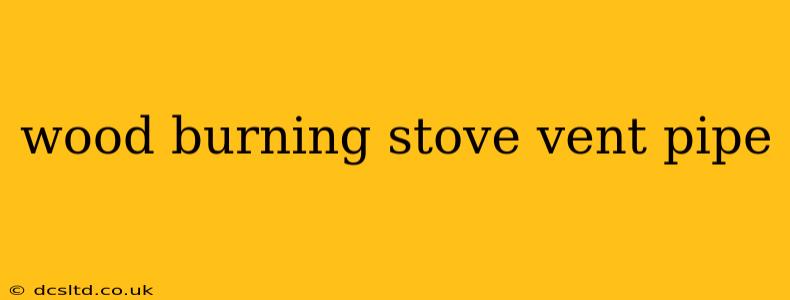Choosing the right vent pipe for your wood burning stove is crucial for safety, efficiency, and longevity. This comprehensive guide will cover everything you need to know, from understanding the different types of pipe to ensuring proper installation. Ignoring these vital details could lead to dangerous situations, such as carbon monoxide poisoning or house fires.
What are the Different Types of Wood Burning Stove Vent Pipes?
Several types of vent pipes are available for wood burning stoves, each with its own advantages and disadvantages. The most common materials include:
-
Stainless Steel: This is the most popular choice due to its durability, resistance to corrosion, and high heat tolerance. Stainless steel vent pipes are designed to withstand the high temperatures generated by a wood-burning stove, ensuring a long lifespan. They are also relatively easy to clean and maintain.
-
Aluminum: While less expensive than stainless steel, aluminum vent pipes are not as durable and are more susceptible to corrosion, particularly in areas with high humidity. They may also be less resistant to high temperatures, requiring more careful attention during installation and use.
-
Black Steel: Black steel pipes are a more budget-friendly option, but they are prone to rust and require regular maintenance to prevent corrosion. They are less resistant to high heat than stainless steel.
How Do I Choose the Right Size Vent Pipe for My Wood Burning Stove?
The diameter of your vent pipe is critical for efficient and safe operation. Using a pipe that is too small can restrict airflow, leading to creosote buildup and increased risk of chimney fires. A pipe that is too large can cause drafting problems, leading to inefficient burning and smoke entering your home. Always consult your stove's manufacturer's instructions for the recommended vent pipe size. This information is crucial and should never be overlooked.
What is the Importance of Proper Vent Pipe Installation?
Correct installation is paramount to ensuring the safe and efficient operation of your wood-burning stove. Improper installation can lead to various problems, including:
-
Carbon Monoxide Poisoning: A poorly installed vent pipe can allow deadly carbon monoxide gas to leak into your home.
-
Chimney Fires: Creosote buildup, often caused by insufficient airflow due to incorrect pipe sizing or installation, can lead to chimney fires.
-
House Fires: Faulty connections or improperly sealed joints in the vent pipe can pose a significant fire risk.
What are the Building Codes and Regulations for Wood Burning Stove Vent Pipes?
Building codes and regulations vary by location. It is essential to check with your local building authority before installing a wood burning stove and its vent pipe. They can provide specific requirements for your area, ensuring your installation meets all safety standards. Ignoring these regulations could lead to fines or even legal action.
How Often Should I Clean My Wood Burning Stove Vent Pipe?
Regular cleaning of your vent pipe is crucial for safety and efficiency. Creosote buildup reduces airflow, increasing the risk of chimney fires and reducing the efficiency of your stove. The frequency of cleaning depends on several factors, including the type of wood used, the frequency of use, and the type of vent pipe. Consult your stove's manufacturer's instructions for recommended cleaning schedules. As a general guideline, at least one annual cleaning is recommended.
What are the Signs of a Problem with My Wood Burning Stove Vent Pipe?
Several signs may indicate a problem with your wood burning stove vent pipe:
-
Excessive Smoke: Smoke entering your home is a clear sign of a problem with the draft, potentially due to a blocked or incorrectly sized vent pipe.
-
Soot Buildup: Excessive soot buildup inside the pipe indicates poor airflow and potential creosote accumulation.
-
Unusual Noises: Unusual noises emanating from the vent pipe may indicate a problem with the pipe itself, such as a blockage or a loose joint.
Can I Install a Wood Burning Stove Vent Pipe Myself?
While some individuals may feel confident enough to install a vent pipe themselves, it is highly recommended to hire a qualified professional. Incorrect installation can have serious consequences, and professional installation ensures compliance with building codes and safety regulations.
This guide provides a comprehensive overview of wood burning stove vent pipes. Remember, safety should always be your top priority. If you have any doubts or uncertainties, always consult a qualified professional. A properly installed and maintained vent pipe is vital for the safe and efficient operation of your wood-burning stove, ensuring warmth and comfort without compromising safety.
